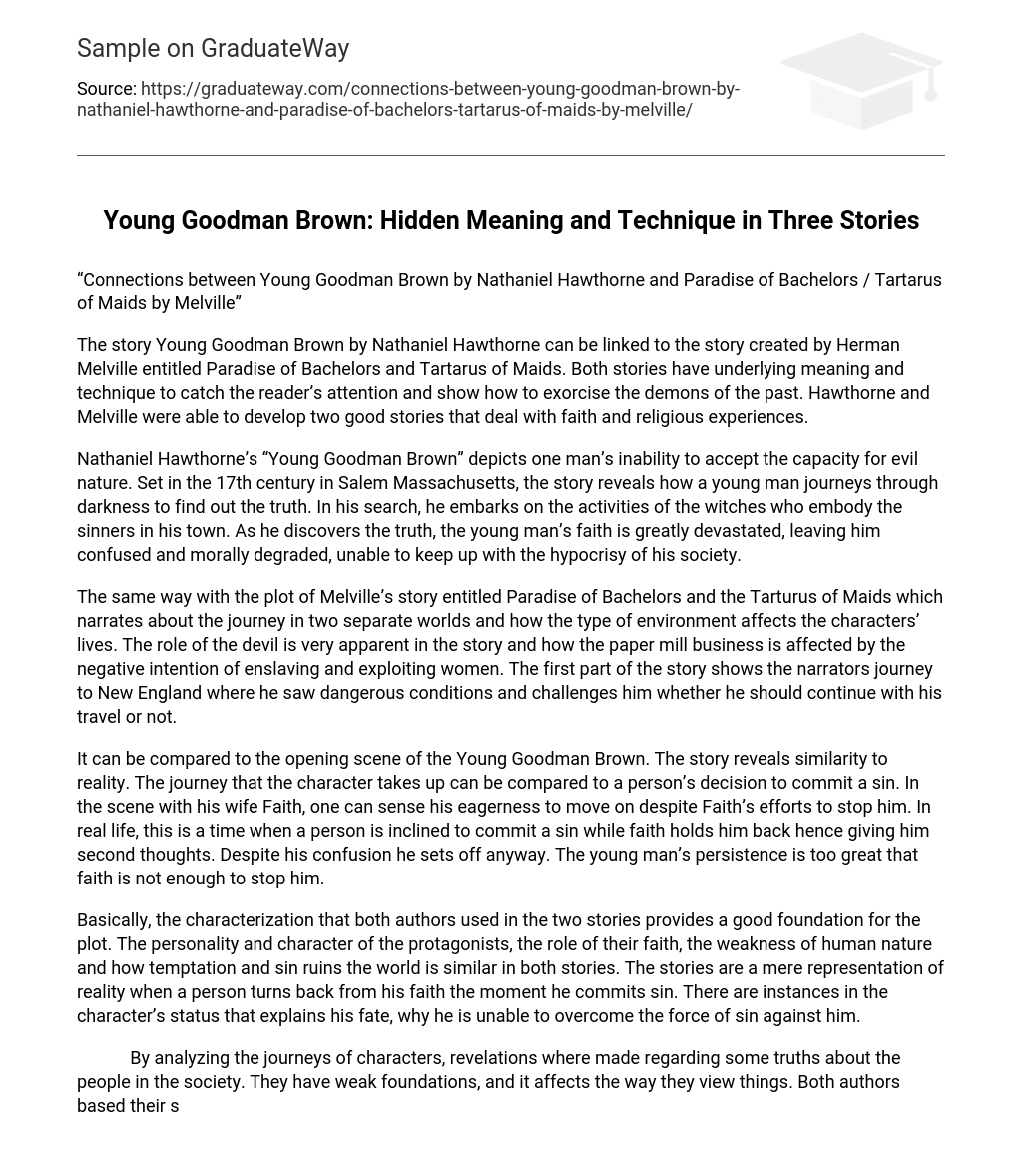“Connections between Young Goodman Brown by Nathaniel Hawthorne and Paradise of Bachelors / Tartarus of Maids by Melville”
The story Young Goodman Brown by Nathaniel Hawthorne can be linked to the story created by Herman Melville entitled Paradise of Bachelors and Tartarus of Maids. Both stories have underlying meaning and technique to catch the reader’s attention and show how to exorcise the demons of the past. Hawthorne and Melville were able to develop two good stories that deal with faith and religious experiences.
Nathaniel Hawthorne’s “Young Goodman Brown” depicts one man’s inability to accept the capacity for evil nature. Set in the 17th century in Salem Massachusetts, the story reveals how a young man journeys through darkness to find out the truth. In his search, he embarks on the activities of the witches who embody the sinners in his town. As he discovers the truth, the young man’s faith is greatly devastated, leaving him confused and morally degraded, unable to keep up with the hypocrisy of his society.
The same way with the plot of Melville’s story entitled Paradise of Bachelors and the Tarturus of Maids which narrates about the journey in two separate worlds and how the type of environment affects the characters’ lives. The role of the devil is very apparent in the story and how the paper mill business is affected by the negative intention of enslaving and exploiting women. The first part of the story shows the narrators journey to New England where he saw dangerous conditions and challenges him whether he should continue with his travel or not.
It can be compared to the opening scene of the Young Goodman Brown. The story reveals similarity to reality. The journey that the character takes up can be compared to a person’s decision to commit a sin. In the scene with his wife Faith, one can sense his eagerness to move on despite Faith’s efforts to stop him. In real life, this is a time when a person is inclined to commit a sin while faith holds him back hence giving him second thoughts. Despite his confusion he sets off anyway. The young man’s persistence is too great that faith is not enough to stop him.
Basically, the characterization that both authors used in the two stories provides a good foundation for the plot. The personality and character of the protagonists, the role of their faith, the weakness of human nature and how temptation and sin ruins the world is similar in both stories. The stories are a mere representation of reality when a person turns back from his faith the moment he commits sin. There are instances in the character’s status that explains his fate, why he is unable to overcome the force of sin against him.
By analyzing the journeys of characters, revelations where made regarding some truths about the people in the society. They have weak foundations, and it affects the way they view things. Both authors based their stories on historical facts but most importantly they based it on the actions of their ancestors and people during era of the story.
The sense of gloom felt by characters is but a reflection of what Hawthorne and Melville felt. They wanted to show that it is counterproductive to have legalistic communities; that religious bigotry accomplishes nothing of long lasting significance; that some of the religious people in the past are guilty of hypocrisy and if truth be told they deserved to be hanged and burned just like the suspected witches in the Salem witch trials; and finally to demonstrate that suspicion can lead to distrust and paranoia.
Nathaniel Hawthorne and Herman Melville were able to accomplish all of the above by creating great works of fiction. They made it possible for readers to believe that the characters in the stories were indeed acting on their own free will. Both were improbable story but worked well to develop the ideas of the two authors.
Reference:
Melville, Herman. (1855). “The Paradise of Bachelors and the Tartarus of Maids”.
Hawthorne, Nathaniel. (1835). “Young Goodman Brown”.





